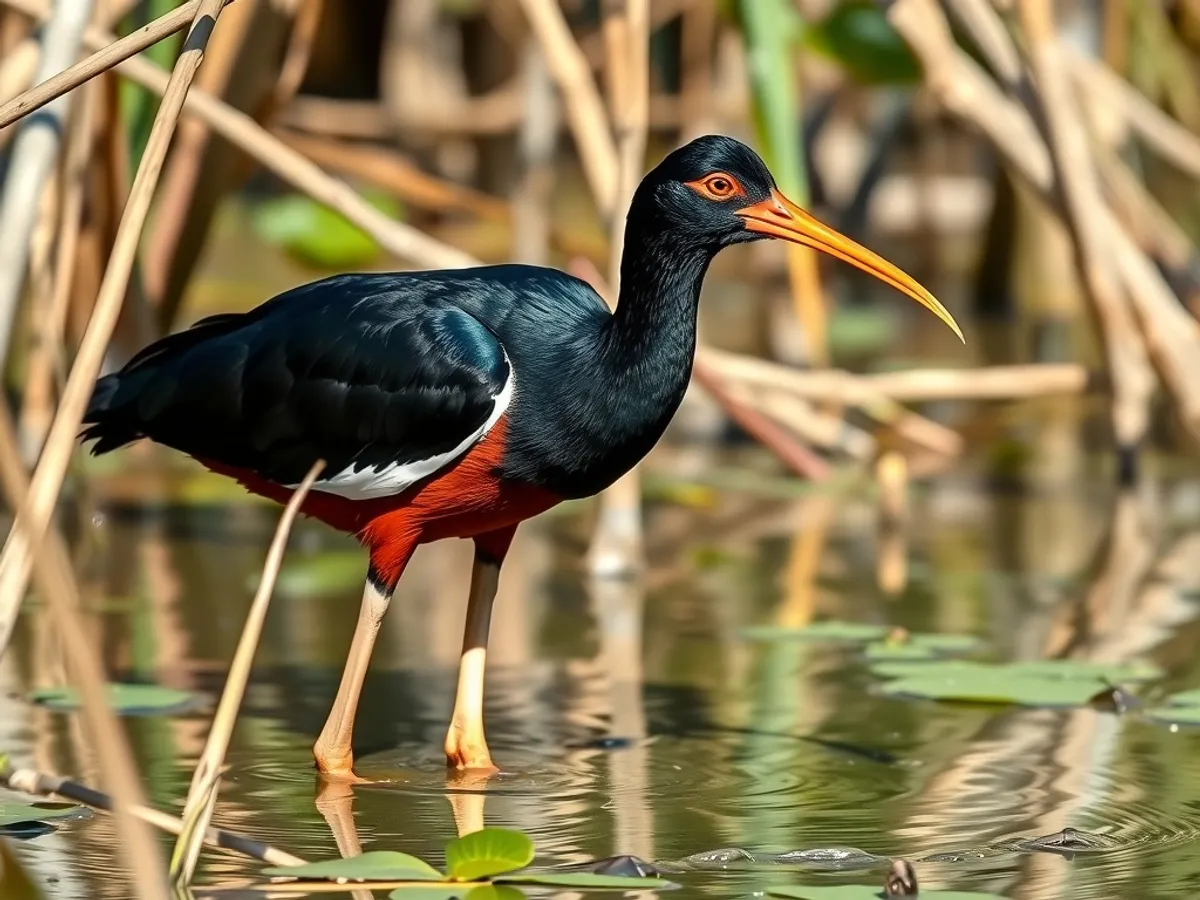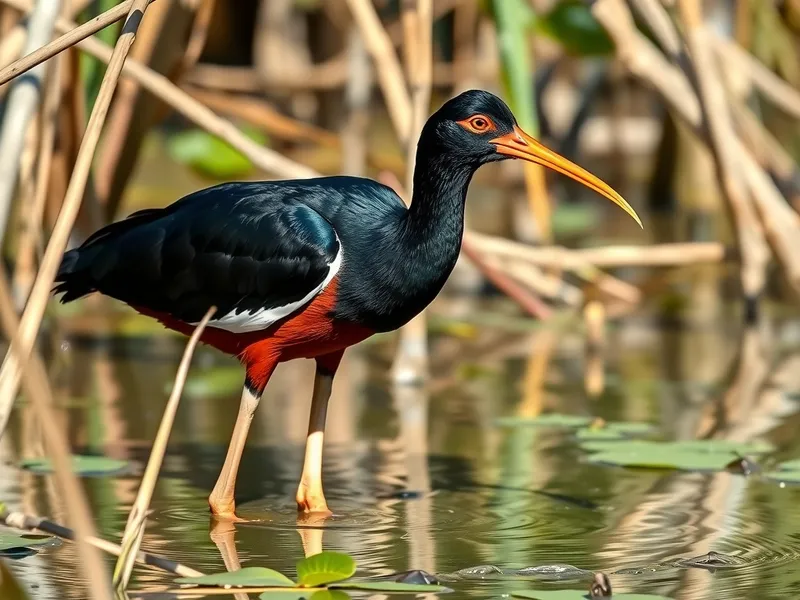
African Jacana
Actophilornis africanus

Meet the African Jacana
The African Jacana is a striking wader bird known for its long toes and claws, which enable it to walk across floating vegetation in shallow lakes and wetlands. It displays a chestnut-brown body, white face, and a distinctive blue frontal shield on its forehead. Males and females look similar, though females are usually larger. This species is well-adapted to aquatic environments and is often seen foraging for insects and other small invertebrates on lily pads. Their unique breeding system features polyandry, where females mate with multiple males, each of which incubates eggs and cares for the young.
Classification
Bird
Habitat
Freshwater wetlands
Diet
Omnivore
Lifespan
5-10 years
Conservation
Least Concern
Weight
137-260 grams
📖Fascinating Facts
Long Toes
The African Jacana's toes are exceptionally long, allowing it to walk on lily pads and other floating plants without sinking.
Male Parental Care
Unlike most birds, male African Jacanas take on the primary role of incubating eggs and caring for chicks.
Polyandrous Females
Female African Jacanas are larger than males and may mate with several males, each tending their own nest.
📋Detailed Description
The African Jacana (Actophilornis africanus) is a medium-sized wader, measuring approximately 23–31 cm in length, with a wingspan of 50–55 cm and weighing between 137–263 grams. Its most distinctive anatomical feature is its exceptionally long toes and claws, which can span up to 10 cm, allowing it to distribute its weight and walk atop floating vegetation such as lily pads. The plumage is predominantly chestnut-brown with a striking white face and throat, a black crown and nape, and a vivid blue frontal shield and bill. Both sexes are similar in appearance, but females are typically larger and heavier, a reversal of the pattern seen in many birds. The underparts are white, and the wings display a rich rufous color in flight. African Jacanas possess a unique polyandrous breeding system, with females mating with multiple males and males providing all parental care. They are highly adapted to aquatic environments, with a preference for shallow lakes, ponds, and marshes rich in floating vegetation. Their diet is omnivorous, consisting mainly of aquatic insects, larvae, crustaceans, seeds, and occasionally small fish. These birds are known for their secretive yet active foraging behavior and are often observed alone or in small groups. Their vocalizations include a series of sharp, high-pitched calls used for communication and territorial defense.
💡 Did you know?
African Jacana chicks can swim and dive underwater to escape predators within hours of hatching.
🔬Research & Sources
Wikipedia Summary
The African jacana is a wader in the family Jacanidae. It has long toes and long claws that enables it to walk on floating vegetation in shallow lakes, its preferred habitat. It is widely distributed in sub-Saharan Africa. For the origin and pronunciation of the name, see Jacanidae.
Last Modified: 5/24/2025
🎭Behavior & Social Structure
African Jacanas are diurnal and spend most of their day foraging on floating vegetation, using their long toes to delicately balance while searching for food. They employ a methodical walking pattern, pecking at insects, snails, and seeds on the water surface or just below it. Socially, they are generally solitary or found in loose aggregations, except during the breeding season when territorial disputes become frequent. Males are highly territorial and will aggressively defend their nesting area from rivals. Both sexes use vocalizations and display behaviors, such as wing spreading and frontal shield presentation, to communicate and deter intruders. During the hottest parts of the day, jacanas may rest in shaded areas or preen their feathers. They are strong fliers but tend to fly only short distances between patches of suitable habitat.
👶Reproduction & Life Cycle
The African Jacana exhibits classical polyandry, one of the few bird species to do so. Females maintain territories that encompass the smaller territories of several males. During the breeding season, which coincides with the rainy season (typically October to March, varying by region), a female will mate with multiple males, each of whom builds a floating nest anchored to aquatic vegetation. The female lays 2–4 darkly speckled eggs in each male's nest. Incubation is performed solely by the male and lasts about 22–28 days. Males use their wings to cover and protect the eggs, and are known for their remarkable ability to carry chicks under their wings, sometimes appearing as if the chicks are 'disappearing' into the adult's body. After hatching, the precocial chicks leave the nest within a day and are cared for exclusively by the male, who leads them to feeding areas and protects them from predators. The female may mate and lay eggs with several males in succession during a single season.
🛡️Adaptations & Survival
The African Jacana's most notable adaptation is its elongated toes and claws, which provide exceptional surface area for weight distribution, enabling it to walk on floating vegetation without sinking. Its lightweight body and hydrophobic plumage further facilitate this semi-aquatic lifestyle. The blue frontal shield is thought to play a role in sexual selection and territorial displays. The polyandrous breeding system is a rare evolutionary strategy among birds, maximizing reproductive output for females while ensuring high parental investment from males. Their cryptically colored eggs and chicks are well-camouflaged against the background of aquatic vegetation, reducing predation risk. Additionally, jacanas have specialized preen glands that help maintain feather waterproofing, crucial for their aquatic environment.
🎨Cultural Significance
While the African Jacana does not have widespread mythological or symbolic significance, it is occasionally featured in local folklore as a symbol of balance and agility, owing to its remarkable ability to walk on water. In some African cultures, its unique breeding system and parental care have inspired stories about gender roles and family structure. The bird is also a favorite among birdwatchers and ecotourists, contributing to the appreciation and conservation of wetland habitats.
🔬Recent Research & Discoveries
Recent research on African Jacanas has focused on their unusual polyandrous mating system, providing insights into the evolution of sex roles and parental care in birds. Genetic studies have confirmed high rates of multiple paternity within broods. Behavioral ecologists have investigated the hormonal mechanisms underlying sex-role reversal and the impact of environmental variability on reproductive strategies. Ongoing studies are examining the effects of habitat fragmentation and climate change on jacana populations and wetland ecosystems. Additionally, the biomechanics of their locomotion on floating vegetation has been explored as a model for bio-inspired engineering.
🎥Wildlife Videos

Jacana - Jesus bird, Lilly trotter or Comb-crested Jacana. A documentary
This video is taken throughout the top end of Australia with footage from WA, NT, Queensland. The Comb-crested Jacana is a ...
Plumes of Oz

Jacana Dad Rescues his Chicks from a Crocodile
“Okavango: River of Dreams - Paradise“ premieres Wednesday, October 23 at 8|7c on PBS --------------- For full NATURE episodes ...
Nature on PBS

10 HRS Amazing Wildlife of Chobe National Park in 8K UHD - Incredible South Africa - Part 1
Amazing wildlife of Africa is already on your screens in 8K Ultra HD resolution! Our filmmaker Robert Hofmeyr filmed this ...
4K Relaxation Channel

African Jacana - 4K clip
African Jacana (Actophilornis africanus) foraging for food - KwaZulu-Natal, South Africa.
Moving Pictures Africa

African Jacana Bird Fishing
Thumbnail credit: Steven #animals #nature #4k #tourism #birds #bird #birdslover #wildlife #africa.
African Safari Adventures

S5 E21: "African Jacanas: Masters of the Floating World"
Embark on an enchanting exploration of the wetlands with Blaze Wildlife in this captivating episode of "Wild Wonder"! Join us as ...
Blaze Wildlife
🌍Habitat Information
The African Jacana typically inhabits Freshwater wetlands environments. African Jacanas have adapted to their environments with specialized features and behaviors.
Primary Habitat:
Freshwater wetlands
More detailed habitat information will be available soon.
🛡️Conservation Status
The African Jacana is currently classified as Least Concern. Conservation efforts are crucial for preserving this species for future generations.
Common Threats:
- 🏠Habitat loss and fragmentation
- 🌡️Climate change impacts
- 🎯Hunting and poaching
- 🏭Human-wildlife conflict
⚠️Threats & Conservation Challenges
Currently assessed as Least Concern by the IUCN, African Jacanas have a wide distribution and stable population. However, they face localized threats from habitat loss due to wetland drainage, agricultural expansion, and pollution. Invasive aquatic plants and changes in water management (such as damming and irrigation) can alter the structure of their habitat, impacting food availability and nesting sites. Predation by birds of prey, large fish, and reptiles is a natural challenge, particularly for eggs and chicks. Climate change poses a long-term threat by altering rainfall patterns and wetland hydrology. Despite these challenges, the species remains resilient due to its adaptability and broad habitat tolerance.
🔬Scientific Classification
Scientific Name
Actophilornis africanus
Classification Hierarchy
🔍 About Taxonomic Classification
Taxonomic classification is a hierarchical system used by scientists to classify and organize living organisms based on shared characteristics and evolutionary relationships.
The system moves from broad categories (Kingdom) to increasingly specific ones, with each animal's scientific name typically consisting of its Genus and species.
📝Community Notes
Share your observations and insights about the African Jacana with our community of wildlife enthusiasts.
Join Our Community
Sign in to share your observations and connect with fellow wildlife enthusiasts.
Sign In to ContributeNo community notes yet
Be the first to share your observations about the African Jacana!
Explore African Jacana
Select a tab above to learn more about this amazing animal.
📸Photo Gallery
No photos available for this animal yet.
🌟Discover More Wildlife
Continue your journey of discovery with more fascinating animals from our database
